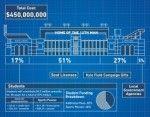The towering construction of concrete, steel and glass has housed generations of Aggies since 1927, and has stood watch while A&M football legends such as John David Crow, Dat Nguyen and Johnny Manziel competed within its walls.
Over the years, Kyle Field has undergone 13 renovations that have expanded its capacity from its original 33,000 to the current 82,589. Wednesday, the Texas A&M System Board of Regents voted for its 14th renovation – a $450 million package that will boost seating capacity to 102,500.
A&M System Chancellor John Sharp said the project represents an opportunity for the University to grow.
“We have committed to making Kyle Field the premier college football stadium in the country, as well as an incredible facility to showcase our flagship University, our unique traditions and the incomparable spirit of the 12th Man,” Sharp said. “This stadium will reflect the dominant prestige and power of Texas A&M University.”
The 19,911-seat expansion will elevate Kyle Field to the third-largest stadium nationwide behind Michigan (109,901) and Penn State (106,572), and the largest in the SEC, surpassing Tennessee’s Neyland Stadium (102,455) by 45 seats.
Furthermore, Kyle Field will reclaim its title as the state’s flagship entertainment venue, eclipsing the capacity of Darrell K Royal-Texas Memorial Stadium of the University of Texas, whose 2005 expansion rendered it the state’s largest stadium.
The renovation will take place over the course of the 2014 and 2015 football offseasons, beginning immediately following the 2013 season. Games will remain at Kyle Field during the construction process.
A&M athletic director Eric Hyman said the renovation will thrust the University onto the national stage once again, and will represent the largest redevelopment of a collegiate athletic facility to date.
“There’s a good foundation to build on as we move forward,” Hyman said. “This significant project is a shared vision and shared experience for all of our fans. Upon completion, we will have immense pride in Kyle Field. It will be unmatched anywhere in the country, with Texas A&M’s history and traditions woven throughout the stadium and its surroundings.”
The expansion will include more than added capacity. Renderings and official statements have shown that both Kyle Field’s exterior and interior will undergo massive overhauls with regards to A&M tradition and fan convenience.
G. Rollie White Coliseum, the Read Building and the Netum Steed strength and conditioning facility will be demolished, all of which are part of or adjacent to Kyle Field.
The renovation, when completed, will showcase a brick, limestone and glass fa?ade along with extensive redevelopment of the exterior plazas and pathways surrounding the stadium. Emphasis on tradition will stand as a central theme throughout the stadium, with memorials honoring former players, students and the University’s core values erected on the east, west and north sides.
The alumni section will house the new Aggie Sports Museum as well as multiple stages of luxury and box suites, with all-inclusive private club access and a premier field view.
The redevelopment also aims to create an even more hostile home crowd environment, hoping to build upon the already intimidating Kyle Field fan experience.
With seating moved closer to the field and the playing surface being lowered approximately seven feet, the noise capacity will be amplified. Additionally, canopies placed over both the east and west sides will serve to “trap” the sound, creating a truly deafening atmosphere.
Head coach Kevin Sumlin said increasing the 12th Man’s effect on the game is yet another testament to the student body’s commitment to the A&M football program.
“I want to do the impossible – I want to make Kyle Field louder than it already is,” Sumlin said. “When I returned to Aggieland, I said that the atmosphere at Kyle Field is second to none. With the 12th Man standing ready, the spirit of Aggieland is real, and the fans really make a difference to our current players as well as our future recruits.”
For Manziel, whose eligibility will last through the 2015 season’s grand opening of the renovated Kyle Field, the redevelopments add an extra dimension to the already intimidating venue.
“I can tell you there is no better feeling than running out of the tunnel onto Kyle Field in front of the 12th Man,” Manziel said. “Our atmosphere is the very best in the country and our fans are smart and loud. I’m excited about the new renovations at Kyle Field because I think we are taking something that is already great and making it even better.”
Funding for the $450 million expansion will come from a variety of sources, ranging from the student body to donations from former students.
Students will contribute $4.9 million annually for 30 years, totaling $75 million and roughly 17 percent of the project, through a combination of increases in the University Advancement Fee and cost of sports passes. The UAF will increase $2.42 per credit hour, or $36.30 per semester for full-time students, while sports pass prices will increase by $11.48 per home game – a total of $80.36 for a seven-game home standard.
Multiple factions around campus opposed the jump in student fees, a fact demonstrated by the five student protestors who rallied outside the Board of Regents meeting.
Headlined by members of the Texas Aggie Conservatives and the student senate, the protestors unsuccessfully lobbied for the regents to table the student payment plan.
Oppositely, recently sworn-in student body president Reid Joseph requested the regents put into writing the fees, which will expire in 30 years.
The 12th Man Foundation will provide 51 percent of funding through seat licensing and former student donations, totaling $229.5 million. The remaining 32 percent will come from Kyle Field Campaign Gifts and local governmental agencies.
Following A&M’s realignment to the SEC in July 2012, the University has received a significant increase in national exposure. Sumlin and Manziel’s success on the gridiron have provided the centerpiece for the publicity, a fact not lost upon administration.
A&M President R. Bowen Loftin believes the expansion of the Aggies’ premier athletic institution will stand as yet another vehicle for growing the Texas A&M brand on a nationwide scale.
“As we have seen with Texas A&M’s transition into the Southeastern Conference, athletics can play a key role in increasing the visibility of the entire university,” Loftin said. “The Kyle Field project is yet another element of enhancing Texas A&M’s profile.”
Big-budget Kyle boosts capacity
May 6, 2013

0
Donate to The Battalion
$2790
$5000
Contributed
Our Goal
Your donation will support the student journalists of Texas A&M University - College Station. Your contribution will allow us to purchase equipment and cover our annual website hosting costs, in addition to paying freelance staffers for their work, travel costs for coverage and more!









